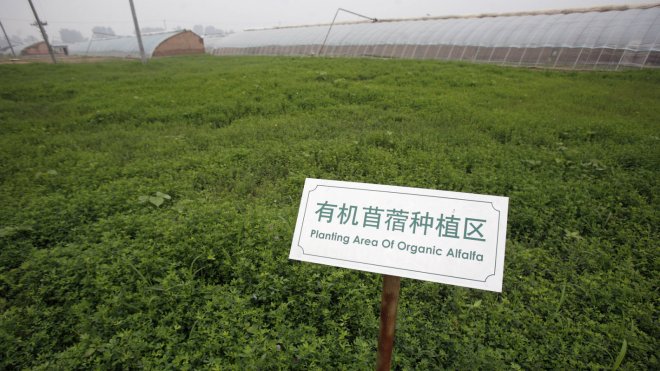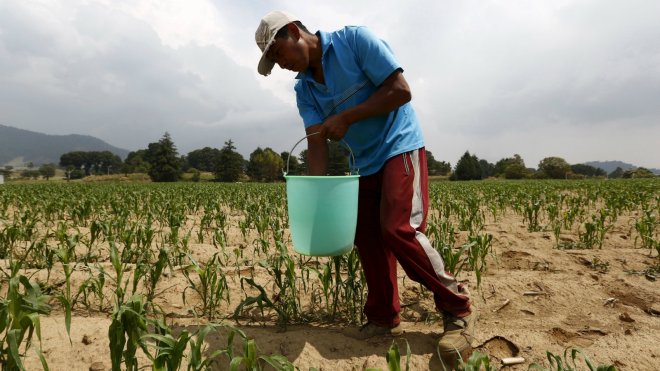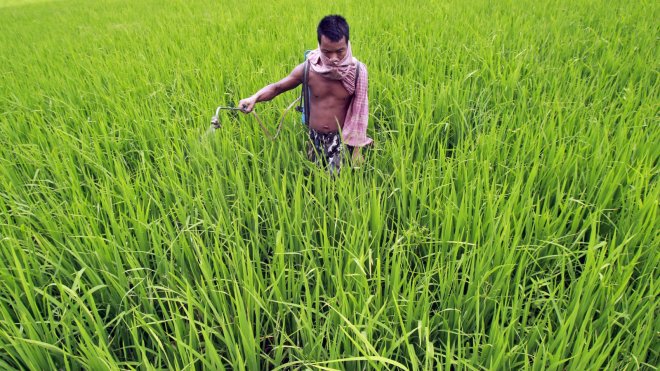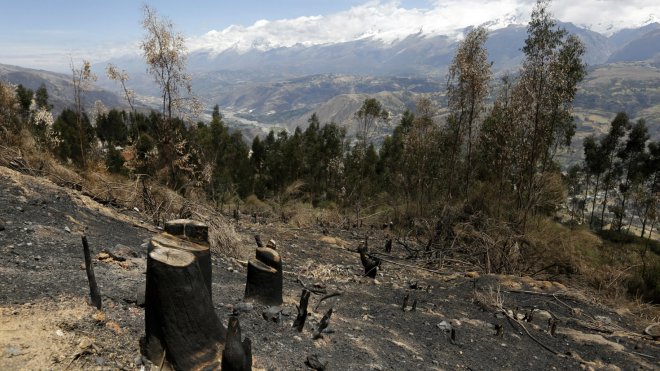One of the most persistent arguments for modern, mechanized agriculture is that it produces a lot of food per acre, leaving more land for other purposes. I’ve often wondered how solid this argument is, and when a debate broke out recently, I decided to look closer.
It started with a paper from a think tank. The Breakthrough Institute study, called Nature Unbound, argued that, by embracing technology, humanity could shrink its footprint and leave more land for “nature.” (I don’t like this way of defining nature as something apart from humans, but that’s a different issue.)
The Breakthrough people call themselves Ecomodernists and have a long history of pissing off environmentalists. Their paper caught the attention of Guardian columnist George Monbiot, who took the Ecomodernists to task for favoring big industrial farming over small. Monbiot pointed out that in many poor countries, the smaller the farm, the greater its yields. This is true: When people only have a small amount of land to support them, they pour all their efforts into that land and eke more food per square foot than their neighbors with more land.
But the Breakthrough guys fired back. Sure, small farms tend to produce more than bigger farms in poor countries, they wrote; but both produce way less than modern industrial farms in rich countries. “One widely cited study found that the smallest African farms produced about 25 percent more yield per hectare than the largest African farms. But the average American farm produced about 10 times more yield per hectare than either. Yield gaps between farmers in rich nations and those in poor countries are profound,” they wrote. This, also, is true.
Both sides here are right in their own way. The Ecomodernists are right in an abstract, thought-experiment way: We could grow more food on less land if every farm were as big and efficient as those in the U.S. Monbiot is right in a pragmatic, best-next-steps way: In reality, the path to higher yields starts with farms getting smaller, rather than larger. That’s what’s happened in Asia — farms are getting smaller, using Green Revolution pesticides and fertilizers, and getting bigger yields.
Both sides of this argument agree that plopping down big industrial farms in Africa or Asia would probably be a disaster. Linus Blomqvist, one of the authors of Nature Unbound, told me this would be a terrible idea, because it would mean that all those small subsistence farmers would have no way of supporting themselves.
But so what? After reading these pieces I was shaking my head. Size just doesn’t matter (when we are talking about farm yields). You can have small farms with high yields, or big farms with low yields, and vice versa. Really, the whole debate was beside the point.
If we are chiefly concerned about environmental impact, farm size matters a lot less than the techniques and technologies those farms use. What I want to know is this: If we choose to eschew the practices of industrial farming, does that mean we’ll have to expand our land base to grow the same amount of food? Can organic yield as much as conventional farming?
Organic versus conventional

Alfalfa is one of the legumes that harbors nitrogen-fixing bacteria.REUTERS/David Gray
In 2007, a group of researchers led by Catherine Badgley made a big-picture estimate of how many additional acres we would need to switch over to 100 percent organic. The number they arrived at was startlingly low: 0 acres. That is, they projected that we could go all-organic without increasing the amount of land used for agriculture one bit.
But then a lot of other researchers chimed in. Wait, wait, wait, they (more or less) protested: Are you really looking carefully at where you are getting your nitrogen?
This is the one giant hurdle that has always stood in the way of organic farming producing as much food as conventional farming. Creating nitrogen fertilizer organically takes space. That’s because there are just two ways to get the nitrogen in our atmosphere into a form that plants can use: Bacteria can do it, or humans can do it by burning decomposed dinosaur goo (i.e. fossil fuel, mostly natural gas), through the industrial Haber-Bosch process. (There’s also some nitrogen fixed by lightning and internal combustion engines, but that’s hard to catch.) Both bacteria and humans start with nitrogen in the air and bind it to hydrogen, creating a form of nitrogen plants can use: ammonia, urea, ammonium, nitrates, or nitrites.
The way you create fertilizer organically is to fill a field with legumes: plants that harbor nitrogen-fixing bacteria. Once they’ve grown, you plow those nitrogen-packed plants into the ground. That takes up time and land that’s not growing food. Of course, you can also feed these plants to cattle, but you lose a lot of the nitrogen in the process, even if you put all the manure back on the field. When you are simply pouring synthetic nitrogen out of a bag, you don’t need this fallow period.
So instead of looking at how much food an acre of land can produce for just one crop, we need to look at how much food an acre of land can produce over multiple years — and account for those fallow years, when nitrogen-fixing crops like legumes are planted. Following the 2007 Badgley study, other researchers looked at this issue — but largely sidestepped the question, arguing that yields didn’t depend on farmers devoting their fields to nitrogen production for a long time. Even so, the new studies found that organic yields were lower than conventional; the best apples-to-apples comparisons had organic producing somewhere around 30 to 20 percent less.
But then researchers protested again: Wait, wait, wait!, I imagine them saying. What about manure?
It’s true that organic farm yields don’t depend on farmers dedicating growing seasons to nitrogen production, but that’s probably because the farmers that spend less time producing nitrogen with legumes apply more manure to their fields. Manure is a big source of nitrogen fertilizer for organic farmers, especially in richer countries. When farmers use manure to fertilize their fields, they are using nitrogen that has traveled through several steps: First it’s crafted by bacteria or people, then it’s absorbed by plants and turned into new growth, then it’s eaten by an animal and pooped out. In the U.S., a lot of the nitrogen that organic farmers get is really synthetic ammonia that has passed through livestock before reaching them in the form of manure. If we did away with this transfer, and instead set aside more land for generating this manure, how many additional acres would we have to clear? No one has done that calculation — it was just too thorny a problem for the researchers to solve.
There’s more to life than yield

Applying fertilizer outside Mexico City.REUTERS/Edgard Garrido
After surveying the science on this, it looks to me like we’d have to significantly expand our farmland if we switched all agriculture over to organic. Now, in theory, the amount of extra land you’d need to go organic could be much smaller if all the small farms in Africa performed as well as the Rodale Institute experimental farm in Pennsylvania. Pour research money into finding improvements, and we might be able to get the yield gap between conventional and organic to disappear entirely.
But you could make the same argument on the other side of the ledger: If you were able to get more conventional farmers to use best practices, we’d also see even more food production from even less land area.
We should also ask: Is it really so bad if we can’t produce the same amount of food on the same amount of land? If we wasted less food, and distributed it more equitably, and ate less meat, we could all feed ourselves well, even with significantly lower farm yields. At least for now.
As population grows over the next 35 years, however, we’re going to have to do it all: reduce waste, farm more efficiently, share more equitably, eat less meat, and increase yields. That’s when things get tougher.
A team led by the big-picture ecology thinker, Jonathan Foley, calculated that, if we do all of those things, we might just be able to freeze agricultural expansion, reduce greenhouse gas emissions, and feed all the people who are going to be with us by 2050. It’s easy enough to note that we waste a ridiculous amount of food, and that many of us are getting fat and could use a reduction in calories, but it’s much harder to turn these trends around. To make matters worse, climate change is driving farm yields down as we struggle. Feeding ourselves is not going to be easy: If we simply dismiss the option of increasing production and try to make up for it in other ways, we will fall short. Falling short would mean converting more land to agriculture — more forests felled, more prairies plowed — which means more greenhouse gas emissions.
This doesn’t mean we seek high yields at any cost. Organic agriculture requires more land upstream of production, because you have to grow nitrogen fertilizer before you can grow food. But conventional agriculture takes up more space downstream from production: Fertilizers wash into waterways creating dead zones; soil washes away, too, and that eventually creates the need for more farmland; the manure lagoons required for confined animal feeding operations dominate space, especially when they leak.
The great strength of organic agriculture is in building up and restoring soil. Better soil structure, in turn, means less erosion and pollution. Perhaps we could do that good soil building, and use some synthetic nitrogen to keep our agricultural footprint from expanding. Rather than forcing a choice between organic and industrial, we should create hybrids out of whatever techniques work best.
When it comes down to it, the limiting factor on organic production is nitrogen fertilizer. And so that leads us to the next question: Is using synthetic fertilizer worse, or better, than using extra land to generate biological nitrogen fertilizer?
Just how bad is synthetic fertilizer?

Fertilizing rice in Agartala, India.REUTERS/Jayanta Dey
There are a lot of problems with nitrogen fertilizer. It creates algal blooms and dead zones in the oceans. It leaches into groundwater, and when people drink that water, it can harm infants. Soil bacteria convert some of the fertilizer into nitrous oxide, a greenhouse gas 300 times more potent than carbon dioxide.
The thing is, we often associate these horrors with synthetic nitrogen, but all this is true of organic nitrogen as well. If we changed nothing else, and simply shifted the source of our fertilizer from factories to bacteria, we’d have the same problems.
The farming practices that go along with biological fixation of nitrogen, however, may reduce some of this pollution — but it’s probably not a huge difference. When agroecologist Tim Crews, now at the Land Institute, reviewed the science comparing biological nitrogen to synthetic nitrogen fertilizer, he found some evidence that there was less fertilizer leaching into the water when the fertilizer was coming from bacteria-harboring legumes. That’s probably because these systems have plants covering the ground for a greater percentage of the year: Plants grab up free nitrogen, preventing its escape. Of course, you can also have cover crops in conventional farms.
When Crews looked at nitrous oxide emissions, he found them in both systems — it’s just that synthetic fertilizer produces emissions all at once, when it’s applied, while biological fertilizer produces emissions for a longer period of time. Both forms of fertilizer were pretty much even on that score. Crews concluded, “The ecological integrity of legume-based agroecosystems is marginally greater than that of fertilizer-based systems. The difference between the two N sources is not nearly as marked as many advocates of sustainable/organic farming believe.”
I’d heard lots of claims about synthetic fertilizer killing the soil, or hurting the soil ecosystem, but Crews hadn’t found any evidence of that. And when I called up Keith Goulding, a soil scientist at Rothamstead Research in England, he said it was just a myth. “We run a long term experiment that has been going 172 years,” he said. “Some of the fields [in that experiment] have been getting large amounts of synthetic fertilizer for a long time, and it’s certainly not killing the soil.”
It’s true, he said, that organic methods can improve soil quality, but you can employ those methods while also using synthetic ammonia. “The way to get that is not to avoid synthetic fertilizer, but to put on manure,” he said.
There is one way, though, that synthetic fertilizer is clearly worse than biological nitrogen: you’ve got to burn a lot of fossil fuels to get it. As Crews writes, “Synthetic N fertilizers are the single most energy expensive input to modern agricultural production.”
It takes around 30 gigajoules of energy to produce a ton of ammonia. The average acre of corn in the U.S. gets 140 pounds of nitrogen fertilizer, so that’s 2.1 gigajoules an acre — a little over 500,000 kilocalories, or 1/30 the total calories in the food the average U.S. farmer grows. (Tamar Haspel calculates 15 million kilocalories per acre of corn.)
That’s a lot of natural gas flowing into our food production. But even so, when environmental scientist David Tilman looked at the trade-off between greenhouse gas emissions from ammonia production and greenhouse gas emissions related to clearing land for more farms, he found it was much better to minimize land use, rather than minimize fertilizer use. And synthetic fertilizer doesn’t have to be so greenhouse-gas intensive: People are already making ammonia using wind power.
So how bad is synthetic fertilizer? Somewhat bad, but probably necessary. Before synthetic fertilizer, farms were limited in their food production by the amount of fertilizer they could produce. In pre-industrial France, a farm girl’s dowry was calculated in the pounds of manure her family’s livestock could provide. More than any other technology, synthetic fertilizer is the thing that’s allowed us to feed our booming global population. Now that we’ve created all these people, we’re stuck with the technology. By 2050, Crews writes, “as many as 5.5 billion people may owe their existence to synthetic N fertilizers.”
Where does this leave us?

Land cleared in Carhuaz, Peru.REUTERS/ Mariana Bazo
It’s clear that cutting down forests for farmland is terrible from a greenhouse gas perspective. The total amount of land clearance for agriculture has leveled out for now; the forests burning in southeast Asia are balanced out by the forests that have returned to New England and Europe.
It’s important to be efficient in our land use with farming. But that doesn’t mean that we all need to stop worrying and love industrial farming. Organic production has a lot to contribute and industrial farming has a lot of room for improvement. In the most recent issue of Daedalus, the journal of the American Academy of Arts and Sciences, ecosystem scientist G. Philip Robinson pointed to the sheer waste involved in nitrogen use:
The benefits of this use are unquestionable and careful augmentation in some regions will be important for closing the yield gaps, particularly in sub-Saharan Africa. There are, however, big environmental costs to this use: of the twelve teragrams of nitrogen applied to U.S. agriculture in fertilizer each year, only about two teragrams are consumed by people. The remainder is added to the environment, where it impacts ecosystems downwind and downsteam.
I didn’t know what a teragram was either, but the point is that 10 out of 12 units of nitrogen we apply is wasted. That’s 83 percent of nitrogen ending up, not as food, but as atmospheric gas, or water pollutant. Surely we can do better. We can also improve our systems for deriving nitrogen biologically.
As we strive toward sustainability, context always matters. In many places it will make sense to maximize production, so as to spare forests elsewhere. In some places, organic makes more sense — where there’s an abundance of manure, or no synthetic fertilizers available, or where there’s plenty of land best used for farms. Sometimes it feels as if the divide between organic and industrial farming is too wide to bridge — but we’re almost certainly going to need the best of both for a future that makes sense.
Correction: This piece originally stated that the Verena Seufert paper in 2012 and the Lauren Ponisio paper in 2015 included the land needed to produce nitrogen fertilizer in farm yield calculations. They did not. Seufert et al. instead simply noted that yields didn’t depend on farmers devoting their fields to nitrogen production for a long time. Grist regrets the error and has sentenced the writer to try and make sense of several more of these studies.



